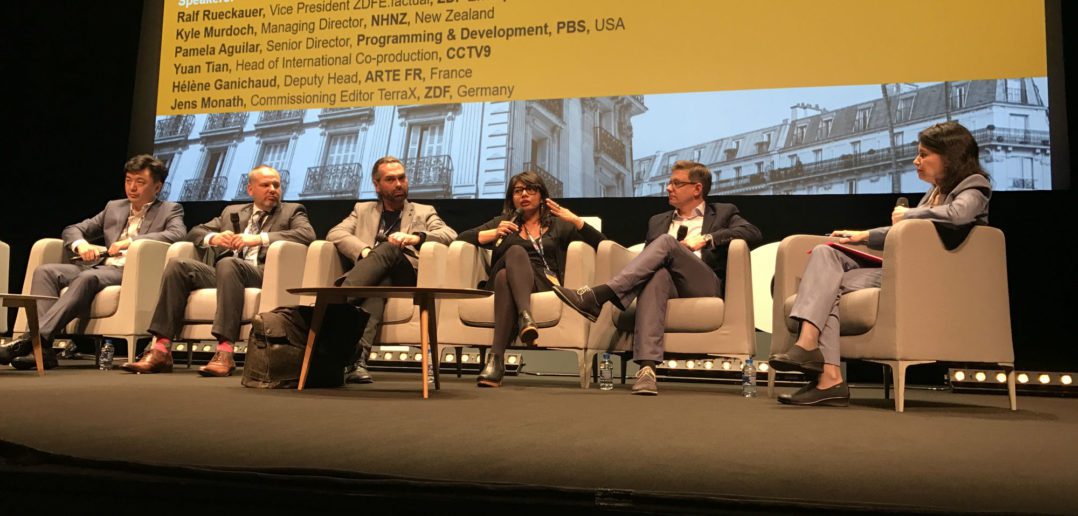High-profile factual programming is all the rage, with co-production continuing to be the model of choice for companies keen to raise the quality bar – not to mention raise the money – for factual shows. Today at MIPDoc, a superpanel convened to discuss strategy.
The panel included: Ralf Rueckauer, VP of ZDFE.factual at ZDF Enterprises; Kyle Murdoch, managing director of NHNZ; Pamela Aguilar, senior director of programming and development at PBS; Yuan Tian, head of international co-production at CCTV9; Hélène Ganichaud, deputy head of ARTE France; and Jens Monath, commissioning editor TerraX at ZDF.
The moderator was Anna Carugati-Guise, group editorial director of World Screen, who noted that ‘co-production’ is a very broad term, asking the panel for their takes on this way of working.
“Co-production is important for us because it brings together financing but also brings together platforms from different parts of the world,” said Murdoch, citing the example of MIPDoc World Premiere Screening Big Pacific, which NHNZ made with PBS, CCTV9, ZDF, ZDF Enterprises, Discovery International, Channel 9 and Arte (the programme, whose trailer is below, was revealed to the MIPDoc audience after this session).
“It’s such a massive geographical area. A lot of the co-producing partners have some sort of link with the Pacific. So you can access parts of China for example that we wouldn’t be able to access without CCTV,” he said.
Aguilar said it’s vital for PBS to engage in co-productions. “What’s important for us is we’re able to really access local productions, local producers from around the world, and also that we’re able to make our dollars stretch… it makes more sense financially so our content can be a lot stronger.”
“It’s way beyond just finance: it’s literally sharing teams and everything else,” said Ganichaud, of one of ARTE’s current co-productions with NHK in Japan.
Aguilar suggested that for PBS, science and natural history are fertile ground for co-productions. “History is a little tougher for us at times. It really needs to relate to an American audience,” she said. “Things like World War II or Vietnam we can do… Some of our signature series do branch out into other genres.”
Ganichaud agreed. “That editorial is probably easier to serve international audiences. It’s less controversial to do a natural-history series!” she said. However, Rueckauer said for ZDF, there is a space for history co-productions. “But I agree it’s locally different. Sometimes we don’t share the same history. Whereas science, natural history, it’s more global from the start.”
Monath noted that there aren’t many “big documentaries” about history, but suggested that because the audiences expect Hollywood-style quality from those shows, broadcasters do need to approach them as co-productions, to ensure the necessary budget can satisfy those demands.
Murdoch praised “big, ambitious, noisy series” for their impact. And in natural history: “The animals don’t date! They don’t change fashion. Animals have behaved in a similar fashion for a long time! But technology does change,” he said. “Co-production for the big natural-history specials? They really work for us.”
PBS consistently attracts millions of viewers for its high-quality factual projects. What fits its remit, wondered Carugati-Guise. “As a public broadcaster, we have the responsibility to bring content that is accessible to the entire public in the US,” said Aguilar. “For us, it’s really endless. We’re constantly looking for new content… Our ratings aren’t our number one priority for our content.”
Monath talked about ZDF’s experience as a public broadcaster, and whether it can do shows that a commercial rival couldn’t. “It’s not as marked as it has been five or ten years ago, that’s for sure, but we cross certain lines that they’re not so sure of,” he said.
Garichaud said that ARTE France’s approach to co-productions depends on the five slots that it is trying to fill. “The strategy is on big, ambitious series that require loads of money, really! As well as access. So that’s natural history, and some drama-docs.”
Tian talked about what CCTV9 wants to offer its viewers, as the biggest public broadcaster in China. “We try to, no matter whether we acquire or we co-produce or produce in-house, we try to bring the highest production values and the best storytelling,” he said. Its factual channel launched in 2011, and has since spawned a number of international co-productions. “We learn from the partners and our other platforms,” he said.
Rueckauer said that ZDF is looking for wildlife, science and history programmes only, but is moving on from its past approach of coming in to projects with finance once they’re already underway. “Over the last couple of years we turned it into another model. We turned it upside down… We want to be a little bit more involved in the creative process, and finance it from the start.”
The conversation turned back to Big Pacific, with Murdoch stressing that the goal was to find unexpected stories from the famous ocean. “Our sizzle wasn’t what people were expecting. It was modern, and a bit edgy,” he said. “It was a very ambitious story, a very ambitious undertaking, a very ambitious business proposition as well. All three.”
“It just gave you goosebumps,” agreed Rueckauer about the sizzle. “It was really outstanding.”
How was editorial control handled on a project with so many cooks? Murdoch said it was a very collaborative process, explaining how NHNZ likes to handle these kinds of co-production. “We hold a summit where we invite the main partners down to New Zealand, or we meet up somewhere, and we discuss the topics face-to-face,” he said. “It means that people have got skin in the game. They really feel like they are involved.”
How important is trust among the partners? “I would say it’s the most important thing, actually,” said Monath, who said the sometimes-rapid changeover of execs within broadcasters can be a challenge for this kind of project.One minute someone is there and signed up to a certain approach, and the next, their replacement is taking a different view. “People change very quickly in television channels. It’s a problem,” he said.
The panel finished off with more Big Pacific. “We decided to base the films, rather than splitting it up geographically, which is quite predictable, we wanted to do something different. So each hour is driven by a different emotion,” said Murdoch. “We have ‘violent Pacific’, and ‘passionate Pacific’, and ‘voracious Pacific’ and then ‘mysterious Pacific’,” he said. The superpanel was then followed by a premiere of the latter episode.




